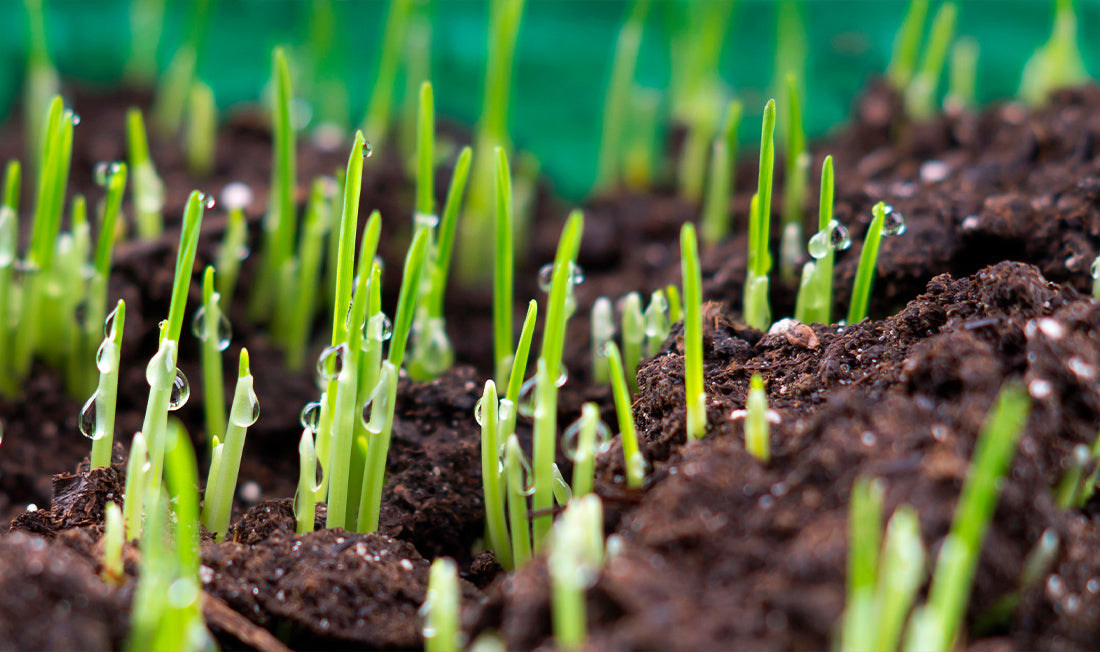There are 17 elements that are considered essential for plant growth. These elements are carbon, hydrogen, oxygen, nitrogen, phosphorus, potassium, sulfur, calcium, magnesium, boron, chlorine, copper, iron, manganese, molybdenum, nickel, and zinc. Carbon and oxygen are obtained from the air, and hydrogen from soil water, but the remainder, referred to as mineral nutrients, are obtained as minerals within the soil. The minerals used in the most significant quantities are referred to as macronutrients and those used in lesser amounts are referred to as micronutrients. Phosphorus falls into the category of macronutrients and plays important roles in the plant lifecycle all the way from the beginning to the end. In this blog post, we will detail what benefits phosphorus provides for plants.
What is phosphorus doing within a grass plant?
Adenosine Triphosphate (ATP) - Phosphorus helps make up ATP, or should we say “O1-{[(2R,3S,4R,5R)-5-(6-Amino-9H-purin-9-yl)-3,4-dihydroxyoxolan-2-yl]methyl}- tetrahydrogen triphosphate”? No? Organic chemistry wasn’t our favorite course either. Think of ATP as the energy currency within the plant. Adenosine triphosphate is the primary molecule for storage and transfer of energy. Your lawn stores the chemical energy created from light energy during the process of photosynthesis as ATP. It then uses that stored energy for ion uptake and biosynthesis.
Nicotinamide adenine dinucleotide phosphate (NADP+) - Phosphorus is also a component of NADP+ and its reduced form NADPH. The reduction of NADP+ to NADPH produces energy that is used for respiration, glycolysis, and fixation of CO2. Without CO2 fixation, photosynthesis would fail.
Phospholipids - Phosphorus makes up a part of plant cell membranes. According to Xue et al. (2009), “recent studies using genetic and molecular approaches reveal the important roles of phospholipid molecules and signaling in multiple processes of higher plants, including root growth, pollen and vascular development, hormone effects and cell responses to environmental stimuli.” All of these processes are essential to healthy, vigorous plants.
Nucleotides - Nucleotides help form the structure of nucleic acids like DNA, tRNA, mRNA, and rRNA. Other enzymes are responsible and necessary for other plant processes to be carried out, like the synthesis of previously mentioned, all important phospholipids.
Phosphorus also helps regulate plant metabolism, is stored in seeds as phosphorus reserves called phytin, and buffers cell pH to maintain internal equilibrium. With all these essential processes and molecules with which phosphorus is associated, you’re probably halfway out the door to go apply some to your lawn right now, but not so fast.
When should I apply phosphorus to my lawn?

Phosphorus should really only be applied in certain situations including seeding or turf establishment and if a soil test indicates a deficiency. In some states, you actually aren forbidden to apply phosphate unless establishing a new lawn or unless your soil test indicates a deficiency. You’ll likely see different values for sufficient soil phosphorus but if you have above 25 ppm (50 lbs / acre) in your soil, that is probably sufficient and continued soil testing to monitor levels would be adequate.

If you conduct a soil test and determine that you do need to apply phosphorus or you’re establishing a lawn, consider using 3-18-18 or 6-18-0 to help correct phosphorus deficiencies or get your seeds off to a great start. 16-4-8 is also a great all-around fertilizer to apply maintenance levels of phosphorus if your soil test shows phosphorus on the low end. If you have any questions about phosphorus related products, or any other questions, contact us for a custom lawn plan tailored to your specific needs.

Citation: Xue, H.W., Chen, X., & Mei, Y. 2009. Function and regulation of phospholipid signaling in plants. Biochemical Journal. 421, 145-156. https://www.doi.org/10.1042/BJ20090300









